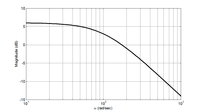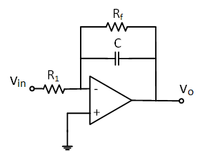
Concept explainers
You would like to design the lowpass filter above that has a frequency response shown by the Bode plot below.
For a lowpass filter, the passband (the frequency range where signals are passed) is at low frequencies and the stop band (the frequency range where signals are attenuated) is at high frequencies. The corner frequency marks the transition between passband and stopband.
If Rf= 5000Ω you will determine the values of R1 and C to complete the design. The design is done in steps. First, determine
the corner frequency (or bandwidth) in rad/sec. Enter Wb in the box below.
Enter the magnitude of the passband gain, KDC. Recall that a gain in dB is related to the linear gain
by the formula KdB = 20log10|k|.
Enter the value for R1 in ohms .
Enter the value for C in μF.


Trending nowThis is a popular solution!
Step by stepSolved in 3 steps with 1 images

- The circuit shown in the given figure is an active filter. Assume C=120 pF. Ro-184 kohm. R₁33 kohm, and R2 = 60 kohm. NOTE: This is a multi-part question. Once an answer is submitted, you will be unable to return to this part. 4-5 www 14 www R₂ 2 ww 644 Determine the cutoff frequencies. The cutoff frequencies w₁ and 2 are 896 106 rad/s and 5.55-105 red/s, respectively. HE -arrow_forward3 20 Determine the center frequency, maximum gain,bandwidth and type of filter (plot the response figure of C₁ R₁ www 68 K ohm 0.05mF R3 www 2.7K ohm 0.01 mF R₂ www 180K ohm R₁ 4.7K ohm wwwarrow_forwardhelp with all parts of the question thanksarrow_forward
- In Matlab for the transfer functionarrow_forwardQ5) Find the transfer function in the following circuit VO/Vi. Draw its frequency response vs Omega (approximation is ok). What kind of filter is this circuit? Low pass/High pass/ Bandpass Write the equation for its cutoff frequency. R M BiwL + VƏarrow_forward
 Introductory Circuit Analysis (13th Edition)Electrical EngineeringISBN:9780133923605Author:Robert L. BoylestadPublisher:PEARSON
Introductory Circuit Analysis (13th Edition)Electrical EngineeringISBN:9780133923605Author:Robert L. BoylestadPublisher:PEARSON Delmar's Standard Textbook Of ElectricityElectrical EngineeringISBN:9781337900348Author:Stephen L. HermanPublisher:Cengage Learning
Delmar's Standard Textbook Of ElectricityElectrical EngineeringISBN:9781337900348Author:Stephen L. HermanPublisher:Cengage Learning Programmable Logic ControllersElectrical EngineeringISBN:9780073373843Author:Frank D. PetruzellaPublisher:McGraw-Hill Education
Programmable Logic ControllersElectrical EngineeringISBN:9780073373843Author:Frank D. PetruzellaPublisher:McGraw-Hill Education Fundamentals of Electric CircuitsElectrical EngineeringISBN:9780078028229Author:Charles K Alexander, Matthew SadikuPublisher:McGraw-Hill Education
Fundamentals of Electric CircuitsElectrical EngineeringISBN:9780078028229Author:Charles K Alexander, Matthew SadikuPublisher:McGraw-Hill Education Electric Circuits. (11th Edition)Electrical EngineeringISBN:9780134746968Author:James W. Nilsson, Susan RiedelPublisher:PEARSON
Electric Circuits. (11th Edition)Electrical EngineeringISBN:9780134746968Author:James W. Nilsson, Susan RiedelPublisher:PEARSON Engineering ElectromagneticsElectrical EngineeringISBN:9780078028151Author:Hayt, William H. (william Hart), Jr, BUCK, John A.Publisher:Mcgraw-hill Education,
Engineering ElectromagneticsElectrical EngineeringISBN:9780078028151Author:Hayt, William H. (william Hart), Jr, BUCK, John A.Publisher:Mcgraw-hill Education,





